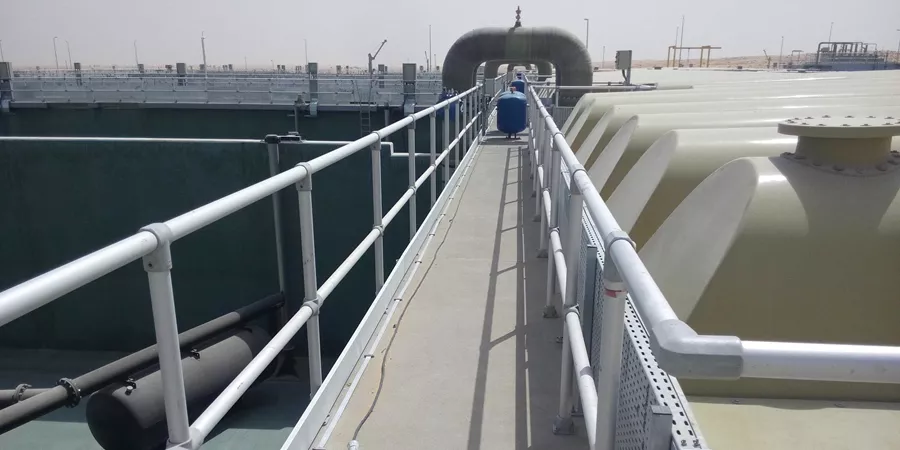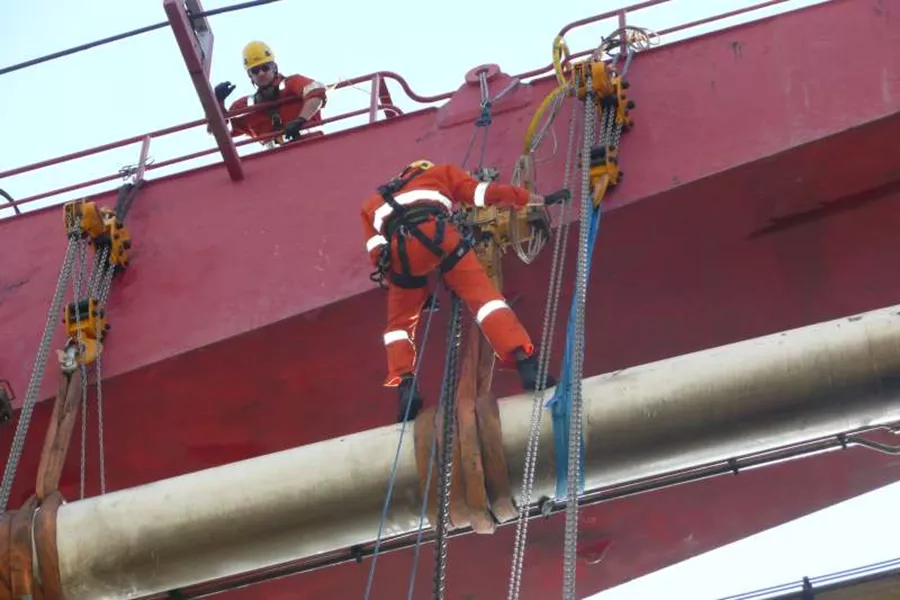
Vous visitez le site Web Canada Kee Safety depuis United States. Voulez-vous aller sur le site de {l'autre pays} ?
Vous visitez maintenant la version française du site Web de Kee Safety.
Two images may first come to mind when visualizing the oil and gas industry. The majesty of an oil rig and filling up your tank at a gas station. Everything in between—pipelines, refineries, storage tanks, and much more—may not be top-of-mind, but they comprise a complex industry where fall protection is a major concern.
The Government of Canada publishes its Oil and Gas Occupational Health and Safety Regulations to cover all industry sectors, upstream, midstream, and downstream. When workers can be exposed to everything from hazardous materials to working at exceptionally tall heights, it is not hard to imagine that these are among the most comprehensive standards set forth for a specific industry.
Upstream is the initial sector of the industry and presents many hazards. For example, climbing a derrick ladder and transitioning to the derrick are inherently dangerous, especially during harsh weather when steps can be slippery from snow or ice. Even under relatively pleasant conditions, grease, rain, and wind present a slip-and-fall hazard.
Derrick hands need to be equipped with a full-body harness and a shock-absorbing or self-retracting lanyard (SRL) attached to a fall arrest anchor point that can withstand a 5,000 lb. (22.24 kN) load. In the event of a fall, the worker should have a descending device to raise or lower the worker to safety. Suspension straps will reduce the risk of suspension trauma.
As dangerous as it is to work at height, piping and lines on the ground also present trip hazards. A pipe step-over platform with anti-slip steps will help prevent falls. Larger crossover platforms with safety railings can handle more involved piping and changes in level.

Offshore rigs account for roughly 25% of upstream operations in Canada. They should not be without extensive safety railings constructed with aluminum or galvanized steel pipe and fittings to provide corrosion resistance and eliminate the need for on-site welding to install.

Upgrader plants at oil sand production fields are complex facilities that require inspections, maintenance, and repairs of building equipment on the rooftop. Personal fall arrest systems (PFAS) or “tie-off” systems not unlike those used on derricks can be employed. Horizontal lifelines are another strong option that can accommodate up to three workers at once.
Vertical and horizontal lifelines need anchor fall protection. If the configuration allows, permanent fall arrest anchors can be installed on the underlying structure of the roof by bolting, casting, welding, or epoxy. Mobile anchor points are designed for flat and low-slope roof areas where permanent anchors are not viable. They use a system of rubber-coated deadweights with suction cups and a tie-off post.
Oil pumping and gas compressor stations are typically located every 30 to 160 kilometers along a pipeline depending upon terrain and other conditions. They are built as high as 12 feet off the ground to avoid flooding and the build-up of snow. Servicing the stations is made easier using modular work platforms.
Constructed of aluminum or galvanized steel bases, frames, and safety railings for strength, durability, and corrosion resistance, modular access platforms feature non-slip treads for the steps and platform areas. The treads can be grated steel or nylon.

Static work platforms are typically used for permanent installation. Mobile work platforms feature heavy-duty, total-lock casters to position and use at different sections. Customized platforms can be designed to accommodate special configurations, adjustable heights, air or electrical connections, and other needs. Whether static, mobile, or custom, these modular platforms can be disassembled and reconfigured with changing worksite requirements.
Cooling towers and other building systems and equipment on the roofs of refineries and other production plants also require extensive inspections, maintenance, and repairs. Fall protection systems including vertical and horizontal lifelines with permanent or mobile anchors provide “personal” fall protection.

“Collective” fall protection, such as a non-penetrating perimeter guardrail system protects one or several workers on the roof without the need for personal fall arrest equipment. A guardrail can also be used with an anti-slip walkway—such as those used on platforms—to provide rooftop or ground-based fall protection. An advantage to collective systems is that they require virtually no worker training to provide fall protection.

Yet, working at heights training is as important to worker safety as the systems and equipment. The International Rope Access Trade Association (IRATA) was established in the U.K. in the late 1980s by oil and gas companies using rope access to provide worker safety on offshore oil rigs. Rope access techniques developed by IRATA are now the worldwide inspection, maintenance, and repair standard.
Rope access training not only helps workers protect themselves, but it also provides the knowledge and training needed for rescue operations on a rig or elsewhere in the industry in the event of a fall. As reinforced by the API, workers should be fully trained in the inspection and use of fall protection devices.

Kee Safety: Your Fall Protection Experts
Kee Safety is the world’s leading fall protection expert. We engineer, manufacture and install fall protection solutions that safely separate people from hazards. Our OH&S-compliant products and systems are third-party tested and trusted to ensure consistent performance at the highest level.